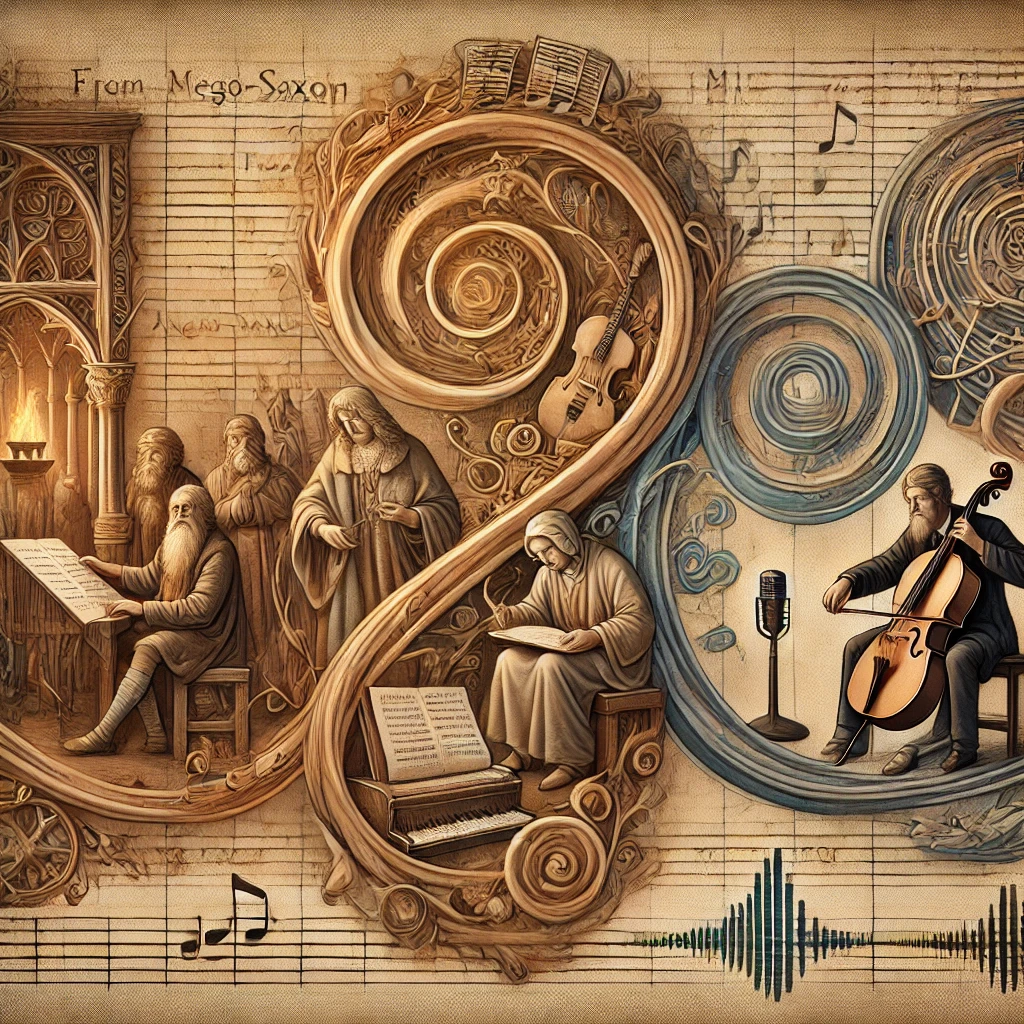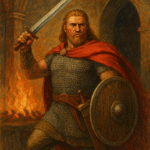From Mead Hall to mic drops, Anglo-Saxon to Contemporary—poetry’s dramatic evolution with flair and fire.
By ABS, The Literary Scholar A.K.A. The Scroll-Bearer of British Verse
“Hwæt!” – And So It Begins
British poetry began not with roses and romance, but with a growl—“Hwæt!”, the Old English equivalent of “Yo, listen up!”.
That’s how Beowulf kicks off. Not subtly. Not shyly. It’s as if the poet slammed open the tavern door and shouted, “I’ve got a monster story, and it comes with alliteration!”
And thus began the thousand-year poetry jam session we now call British literary history.
This is not a dull parade of dead white men and their overlong sonnets. No, no. This is a reality show of rebels, heartbreakers, God-fearers, and word warriors, all trying to out-rhyme each other through plagues, wars, love affairs, and (more tragically) bad hair centuries.
Let’s start the scroll…
The Anglo-Saxon Era: When Poetry was Grit, Guts, and God
Welcome to the 7th century. Life is short, swords are sharp, and poetry is alliterative.
This era gave us Beowulf, the original action hero, fighting monsters with confidence and complex kennings.
“Fate goes ever as fate must.” — Beowulf
Translation: YOLO.
Old English poetry was all about exile, death, God, and cold weather. A lot of cold weather.
Take The Wanderer—a man roaming the seas, grieving his lost lord, and thinking deeply about life’s futility.
Basically, he’s the original emo.
“Where is the horse gone? Where is the rider?” — The Wanderer
Even the horses ghosted back then.
But here’s the kicker: there were no rhymes. Just alliteration, epic mood, and a fatalistic sense of “Wyrd” (fate). These poets walked so modern nihilists could sulk.
Chaucer’s 14th Century: Rhymes, Rudeness, and Road Trips
Fast forward to the 1300s and meet Geoffrey Chaucer—poet, diplomat, and low-key gossip king.
He wrote The Canterbury Tales, which is essentially a medieval UberPool of misfits heading to a shrine, trying to out-story each other.
“Ful wys is he that kan himselven knowe.” — The Pardoner’s Tale
(Wise is he who knows himself… especially before WiFi exposed him.)
Chaucer brought:
-
Bawdy humor (hello, Miller’s Tale)
-
Satire of social classes (everyone gets roasted)
-
And rhyming couplets that still slap.
Let’s be honest, if Chaucer had Twitter, he’d be a trending thread every week. “What if a Knight, a Prioress, and a drunk Miller walked into a pilgrimage?”
The Renaissance: Sonnet Season and Theatre Drama
Cue the 16th century and the great rebranding of poetry.
Enter: Shakespeare, Marlowe, Sidney, Spenser.
This is the era when poets:
-
Wrote sonnets like love was a terminal illness
-
Fought with words (and sometimes swords)
-
Believed in iambic pentameter more than God
“Shall I compare thee to a summer’s day?” — Shakespeare
Yes, if that summer’s day is unpredictable and prone to thunderstorms.
Also, Shakespeare invented half the English language. And probably stole the rest from Latin.
Even Christopher Marlowe, Shakespeare’s edgier, eyeliner-wearing rival, had flair:
“Come live with me and be my love…”
Translation: I have a lute and no job, but I’m romantic.
This was the original era of poetic thirst traps.
The Metaphysical Poets: Love, Death, and Scientific Flexing
In the 17th century, things got… complicated.
Enter: John Donne, the man who could seduce you and philosophize about your mortality in the same stanza.
“Batter my heart, three-person’d God…” — Donne
Calm down, John. Take a breath.
Metaphysical poets loved:
-
Paradoxes
-
Religious angst
-
Scientific metaphors in bed
Donne could say:
“The flea that bit both of us is now our marriage bed.”
And somehow make it sound deep and sexy.
Imagine Tinder bios written in metaphysical conceits:
“Let us melt, and make no noise…” (whispers in existentialism)
Neoclassicism: Order, Rules, and Savage Politeness
Here come Pope and Dryden, with their wigs, wit, and absolute obsession with balance.
Alexander Pope:
“To err is human, to forgive divine.”
Also Pope: “If you’re dumb, I’ll say it in a couplet and you’ll still feel it.”
This was the era of heroic couplets—tight, polished, snarky.
It’s like Twitter, but in 18th-century English and ten times more elegant.
Also, satire was their cardio.
Romanticism: Nature, Feelings, and Too Many Clouds
Late 18th century, cue the moodiest poets ever: Wordsworth, Coleridge, Keats, Shelley, Byron.
If the Enlightenment said, “Use reason,” the Romantics said, “I saw a daffodil and wept for six hours.”
“Poetry is the spontaneous overflow of powerful feelings.” — Wordsworth
Also Wordsworth:
“Let me describe this tree for 47 lines.”
Then there’s Byron, the original hot mess:
“Mad, bad, and dangerous to know.”
This is the era where poetry became the Tumblr of the 19th century—lots of sighing, longing, and vaguely unhealthy relationships with mountains.
The Victorians: Morality And Melodrama In Monologues
Ah, the Victorians. Always dramatic, always proper.
Tennyson, Browning, Rossetti.
They gave us long poems, moral dilemmas, and characters talking to themselves for pages.
“Theirs not to reason why, theirs but to do and die.” — Tennyson
This is poetry… with military anxiety.
Also:
“That’s my last Duchess painted on the wall…” — Robert Browning
Which is basically a poetic true crime confession.
Modernism: Confusion, Coffee, And Consciousness
20th century poets were done with rules.
T.S. Eliot:
“April is the cruellest month.”
April: “What did I do?”
Modernists wrote poetry that felt like a puzzle, a therapy session, and a philosophical crisis all in one.
W.B. Yeats:
“Things fall apart; the centre cannot hold.”
Spoiler: He wasn’t just talking about poetry.
Postmodernism & Contemporary: Fragmentation & Freestyle
Then came the Postmodernists—who questioned whether language meant anything at all.
Poets became:
-
Performers
-
Activists
-
Instagram captions
But even today, echoes of Anglo-Saxon laments and Romantic sighs linger in the margins.
“Poetry is not a luxury. It is a vital necessity of our existence.” — Audre Lorde
From Beowulf to Benjamin Zephaniah, from Chaucer to Carol Ann Duffy, British poetry remains a beautifully chaotic, ever-evolving art form.
Because in every age—no matter how royal, rebellious, or ridiculous—there’s always someone trying to make sense of the world through verse.
And if they can sneak in a metaphor for heartbreak while they’re at it, even better.
Scrolls may end, but the silence between verses still speaks.
ABS lifts the quill, lets the ink settle, and walks into the hush between two heartbeats.
—
When pilgrims spoke, society confessed—verse by verse.
Signed,
ABS, The Literary Scholar
“Every era had its monsters. Every age needed its verse.
Between the bloodshed and the beauty—there was always poetry.”
— ABS, The Literary Scholar
By ABS, The Literary Scholar
Because before Thor had a hammer, Beowulf had a bare chest and a cause
Share this post / Spread the witty word / Let the echo wander / Bookmark the brilliance


